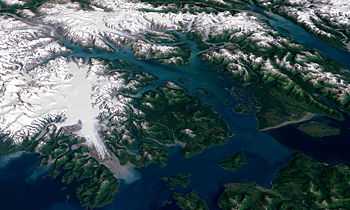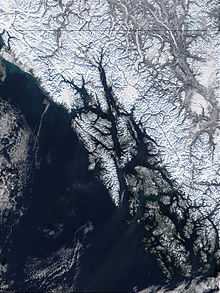Brady Glacier
From Wikipedia, the free encyclopedia

A Landsat image of part of the Glacier Bay National Park and Preserve, with the Brady Glacier in the left foreground, August 1, 1999.
When George Vancouver first set eyes on the Brady Glacier in 1794, it was a calving tidewater glacier that dumped ice into the Taylor Bay. The following century, the glacier advanced eight kilometers. This advance was taken by Bengston (1962) as a sign of the glacier changing from a tidal to non-tidal one. Bengston also stated that the huge outwash plain at the glacier's terminus allows it to preserve itself even as most glaciers in the region retreated. The Brady Glacier has an ELA (the line above which snow remains even after summer's end) of only 800 meters, one of the lowest in Alaska.[1]

Map showing the region of the Brady Glacier

A view of the Glacier Bay National Park and Preserve.
See also
References
- ↑ "Brady Glacier, Alaska begins a substantial retreat". Retrieved 1 March 2013.
Coordinates: 58°34′52″N 136°47′02″W / 58.58111°N 136.78389°W
This article is issued from Wikipedia. The text is available under the Creative Commons Attribution/Share Alike; additional terms may apply for the media files.